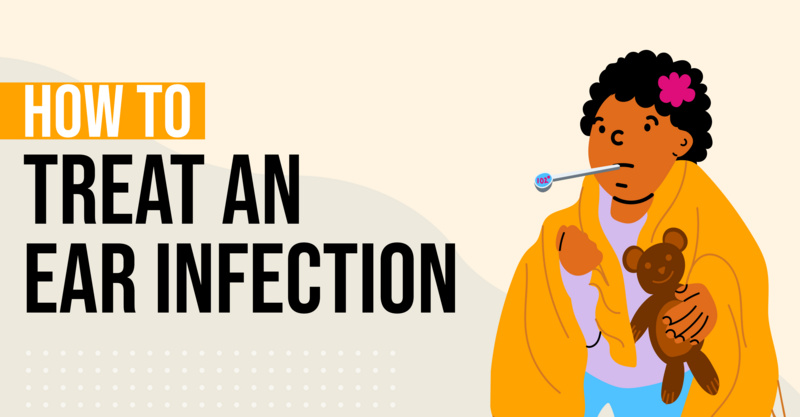Key Points
- Ear infections are caused by viruses, bacteria, and fungi, and can lead to permanent hearing damage if left untreated. Symptoms include sharp pain, pressure, a dull ache, popping sounds, and itchiness in the ear.
- Ear infections are diagnosed through a medical exam using an otoscope to look for signs of inflammation and infection. The type of infection and treatment needed is determined after this examination.
- Ear infections are common in very young children and can lead to developmental and language delays, as well as permanent hearing loss. Signs of an ear infection in a child include fussiness, loss of balance, changes in appetite and eating habits, tugging or rubbing the ears, and fever.
- There are two common types of ear infections: Swimmer’s ear (outer ear infection) and Middle ear infection. Both have distinct causes and treatments. A third condition, fluid in the ears, can cause similar symptoms but does not involve an infection.
- Ear infections can be serious and should be treated promptly. If unable to see a regular doctor, urgent care clinics offer same-day care for diagnosis and treatment.
Maybe you’ve felt a sharp pain or pressure building deep inside your ear. Or you’ve experienced a dull ache and heard popping in your ears when you yawn. Or perhaps your ears have felt itchy and inflamed. All of these can be signs of an ear infection.
Ear infections come in a couple of different types. Each type of ear infection has a distinct cause and effect on the ear, and each type of ear infection calls for its own kind of treatments. While ear infections are not talked about as contagious, the things that cause them (viruses, bacteria, and fungi) can indeed spread from person to person. There are some preventative measures you can take to avoid ear infections moving forward!
As you probably can attest to, ear infection symptoms are painful. If left untreated, they can lead to permanent hearing or ear damage. In the worst cases, the infection can spread to other parts of the body and become life threatening.
Diagnosing ear infections
Ear infections are diagnosed through a medical exam.
The doctor looks in the ear canal with a medical instrument called the otoscope, which makes it possible to look in the ear canal down to the eardrum for signs of an inflammation and infection.
With the otoscope pointing in the ear the doctor looks to see if the eardrum is bulging indicating that fluid has gathered in the inner ear. If that fluid is red in color or cloudy that points to an infection in the middle ear.
The doctor also looks at the ear canal for skin irritation, inflammation, and redness. These are indications of a different kind of ear infection often referred to as swimmer’s ear. The doctor also looks for fluid leaking from the eardrum, which may or may not be infected, but indicates that the eardrum has been damaged.
Only after examining the ear can the doctor identify the type of ear infection present and what treatment is needed.
Recognizing ear infections in children
Ear infections are common among very young children (6 to 18 months old) and elementary school aged children. And they can be quite serious. If a young child has recurring ear infections it can lead to developmental and language delays and even permanent hearing loss. So it’s important to take your child to the doctor when you suspect they have an ear infection.
Children feel the same pain as adults when it comes to ear infections. But with the physical indications being in the ear and out of sight it might not be obvious when a very young child has an ear infection. Very young children, with their limited ability to speak, might not be able to tell you that their ears hurt. This can make it difficult to recognize that your child has an earache or infection.
Here are some signs that your child might have an ear infection:
- Fussines
- Loss of balance
- Change in appetite
- Change in eating habits
- Tugging and/or rubbing the ears
- Fever
Several of these can look like what happens with normal growth and development, making it easy to miss that your child has an ear infection.
Ear tugging or rubbing is the telltale sign for an ear infection in a very young child. When a child keeps tugging at their ears chances are they have an ear infection and should be seen by a doctor as soon as possible. If the child also has a fever (102°F for children 3 months or older, 100.4°F for infants up to 3 months old) that’s an indication of infection, definitely making it time to see a doctor.
Children have a few unique risk factors that make them prone to ear infections.
The most common is that their Eustachian tubes are shorter and more horizontal. This makes it easier for this connection between the middle ear and the respiratory system to become clogged and infected.
Other risk factors for children include:
- Lying on the back while drinking or feeding
- Using a pacifier
- Being around tobacco smoke
- Cleft palate or Down syndrome
- Premature birth
For very young children recurring ear infections (3 infections within 6 months or 4 infections within a year) can have longer term effects. The temporary hearing loss and disruption balance, sleep, and eating that comes with ear infections in very young children can lead to language and developmental delays. Repeated ear infections can also lead to permanent hearing loss.
If you suspect your child has an ear infection it’s best to see a doctor as soon as possible and have it diagnosed.
Causes of ear pain
There are two common types of ear infections and a third condition that looks a lot like an infection that can cause ear pain. Each type has a distinct cause and course of treatment.
The two types of ear infections are:
- Swimmer’s ear, also referred to as an outer ear infection or otitis externa (OE)
- Middle ear infection, or otitis media (OM)
The third condition is fluid in the ears, also referred to as serous otitis media (SOM) or otitis media with effusion (OME). This condition is caused by fluid building pressure against the eardrum. But there is no infection so no antibiotic or antifungal treatment will be prescribed.
Swimmer’s ear
Swimmer’s ear, also called otitis externa or an outer ear infection, is triggered by moisture in the ear canal that creates a welcoming environment for bacteria or fungus to grow.
It can also be caused by damage to the skin in the ear canal. Putting foreign objects in the ear, irritation from hair products, and dry skin conditions like eczema, psoriasis, or acne can cause scratches, flaking, and inflame the skin in the ear canal.
Once the skin in the ear canal is affected inflammation and swelling occurs, causing pain, itchiness, and possibly pus to discharge. The treatment prescribed depends on whether a bacterial infection or fungus is present. Generally an outer ear infection clears up in 7-10 days, but it can last longer.
Prescribed Treatments for Swimmer’s Ear
The doctor may prescribe an ointment or drops to get rid of the bacteria or fungus present. Additionally, ear drops can be recommended to dry and clean out the ear canal.
Self Care for Swimmer’s Ear
You may find that a warm compress to the outside of the ear helps relieve pain and discomfort. Over the counter painkillers, like acetaminophen or ibuprofen, can also help. And keep your outer ear clean and dry.
Risk Factors for Swimmer’s Ear
- Swimming, bathing, or any activity that gets water in the ear canal
- Hot, humid climate
- Using earphones or earbuds
- Using swabs to clean ears
- Narrow or hairy ear canals
- Skin irritations or allergy that spread into the ear canal
- A medical condition that causes dry skin (like eczema) or increases the risk of skin infections (like diabetes)
Complications of Swimmer's Ear
While the most serious complications are rare, there are some more common complications to look for.
- Repeated infections
- Scar tissue in the ear canal
- Inflamed or burst eardrum
- Pus filled lump (abscess) in or around the ear
- Infection spread to the face or deeper layers of the skin (cellulitis)
- Infection spread to cartilage or bones within the skull (malignant otitis externa)
The most serious of these complications are more likely for people with a weakened immune system or an underlying medical condition.
Preventative measures you can take:
- Clean only the outer, visible part of the ear
- Don’t put foreign objects into the ear canal
- After swimming or bathing dry your outer ears well
- Use only clean, dry towels
- Don’t share used towels
Middle Ear Infection
Middle ear infection, or otitis media, often starts with a viral nose or throat infection, like a cold or the flu. The infection spreads to the middle ear through the Eustachian tubes, which can get blocked keeping mucus from draining away and creating the conditions for bacteria to grow.
Pain is felt when the buildup of mucus in the middle ear stretches the eardrum. The doctor, using an otoscope, looks at eardrum for signs of bulging or a tear. An infection is evident when the mucus build up behind the eardrum is red in color or cloudy. Mucus draining into the ear canal indicates a tear to the eardrum.
Middle ear infections can clear up completely in 1-2 weeks and the earache that comes with it can go away in 2-3 days. For this reason if there’s no clear indication of an infection the doctor might wait 48 hours before prescribing antibiotics.
Prescribed Treatments for Middle Ear Infection
When there is a clear indication of infection antibiotics are prescribed. The doctor may also ear drops that contain a painkiller and soften earwax to relieve the pain and pressure of the ear infection.
Self Care for Middle Ear Infection
A warm compress to the outside of the ear can help relieve pain and discomfort. Over the counter painkillers, like acetaminophen or ibuprofen, can also help.
Risk Factors for Middle Ear Infection
- Being prone to colds
- Being exposed to the flu
- Being in crowds and crowded environments
- Being around tobacco smoke
- Having a weakened immune system
Complications of Middle Ear Infections
Again, the most serious complications are rare. But there are other, more common, complications to look out for.
- Burst eardrum
- Vertigo (dizziness)
- Tinnitus (ringing in the ears)
- Temporary hearing loss
- Temporary facial paralysis
- Infection spread to the mastoid bone behind the ear (mastoiditis)
- Infection spread to the inner ear (labyrinthitis)
- Infection spread to the brain and its lining (meningitis)
If the infection spreads see a doctor for a follow up. These are serious complications that can be life threatening.
Preventative measures you can take
- Practice good hygiene to avoid exposure to cold and flu
- Avoid people with cold or flu symptoms
- Get a flu shot
- Clean only the outer, visible part of the ear
- Don’t put foreign objects into the ear canal
- Wash your hands
Get on the road to recovery the same day at an urgent care clinic
Ear infections aren’t just painful, they can be dangerous. When left untreated ear infections can lead to serious complications, including hearing loss. When you suspect that you, or your young child, has an ear infection it’s important to quickly get diagnosed and start treatment.
Sometimes it’s just not possible to get in to see your regular doctor on the same day. Urgent care clinics offer same day care. You’ll be treated by a qualified, experienced medical professional in your neighborhood. Book your appointment online and your wait time is minimized.
With a same day appointment at an urgent care clinic you’ll be on the road to recovery in no time.
Frequently asked questions
What are the symptoms of an ear infection?
Symptoms of an ear infection can include a sharp pain or pressure deep inside the ear, a dull ache, popping sounds when yawning, and itchy or inflamed ears.How are ear infections diagnosed?
Ear infections are diagnosed through a medical exam. A doctor uses an otoscope to look in the ear canal down to the eardrum for signs of inflammation and infection. The doctor also checks for skin irritation, inflammation, and redness in the ear canal, and for fluid leaking from the eardrum.What are some signs that a child might have an ear infection?
Signs that a child might have an ear infection include fussiness, loss of balance, changes in appetite or eating habits, tugging or rubbing the ears, and fever.What are the risks of recurring ear infections in children?
Recurring ear infections in very young children can lead to language and developmental delays and permanent hearing loss.What are the common types of ear infections?
The two common types of ear infections are Swimmer’s ear, also known as an outer ear infection or otitis externa, and a middle ear infection, or otitis media.What causes Swimmer's ear?
Swimmer’s ear is triggered by moisture in the ear canal that creates a welcoming environment for bacteria or fungus to grow. It can also be caused by damage to the skin in the ear canal from foreign objects, irritation from hair products, or dry skin conditions like eczema, psoriasis, or acne.What causes a middle ear infection?
A middle ear infection often starts with a viral nose or throat infection, like a cold or the flu. The infection spreads to the middle ear through the Eustachian tubes, which can get blocked, preventing mucus from draining away and creating the conditions for bacteria to grow.What are some preventative measures for ear infections?
Preventative measures for ear infections include practicing good hygiene to avoid exposure to cold and flu, avoiding people with cold or flu symptoms, getting a flu shot, cleaning only the outer, visible part of the ear, not putting foreign objects into the ear canal, and washing your hands regularly.


 Twitter
Twitter LinkedIn
LinkedIn










